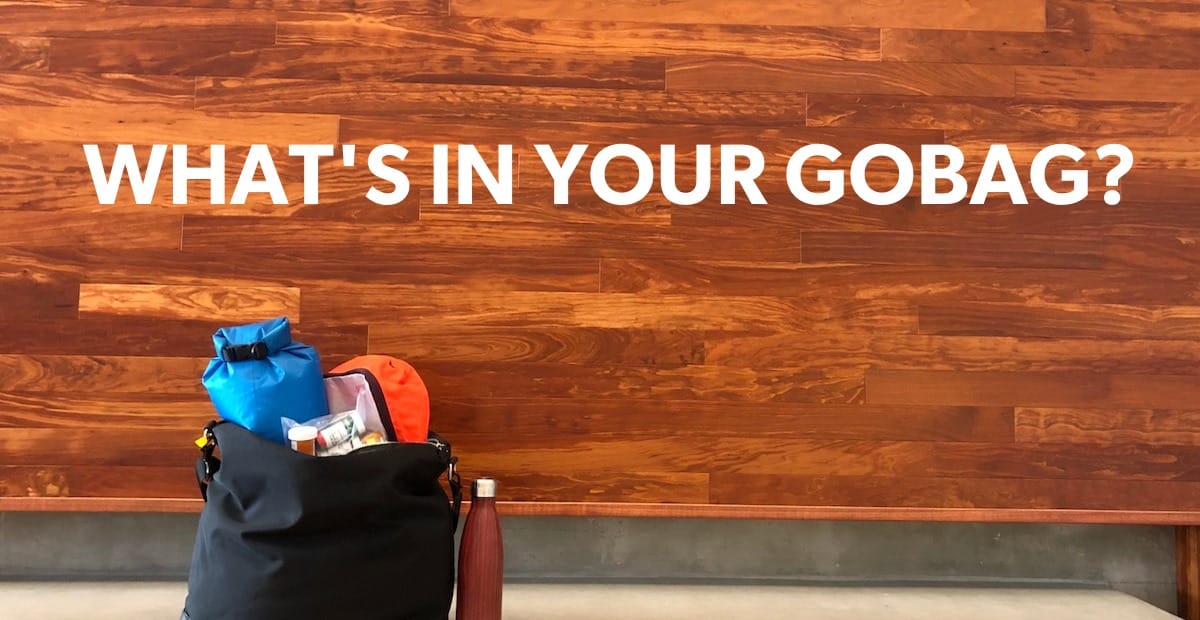If you couldn’t return home or had to leave suddenly, what items could you not live without? In this blog, learn all about Go Bags—what they are, and what needs to be in them.

WHAT IS A GO BAG & WHY HAVE ONE?
A Go Bag is a bag, pack or duffle that is always with you wherever you are, and holds all the essential items that you can’t live without. It can be stored in your vehicle, or on your chair for local activities, work, errands or in case of emergency evacuation. It’s also an essential piece of baggage to take when you travel locally, or internationally.
Whether you’re visiting a friend and you’re unable to return home, you can’t get home due to travel delays, or you must suddenly leave home or head to the hospital—forgetting essential supplies can range from inconvenient to problematic or potentially life-threatening. Having a fully stocked Go Bag ensures that you have everything you need to adapt to any situation. For example, if you’re out of town, the local drugstore may not have what you need, or if it’s a Sunday in a small town, they may not even be open. Even if you’re in a hospital, they likely won’t have all the things you need right away—including medications. A Go Bag will help you get out of a sticky situation. Plus, it gives you peace of mind!
To help you get started with creating your Go Bag, we interviewed SCI BC peer staff members, as well as peer, and intrepid traveller, Roger Jones, and compiled this list of items they won’t leave home without!
THREE DAYS WORTH OF THESE ESSENTIALS
Make sure your Go Bag has a 72 hour/3 day supply of medication and bowel and bladder management supplies.
Medication
- Surprising as it may seem, hospitals may not be able to get the exact medication or dose that you need right away—this is why a 3-day supply is essential.
- Also, remember that hospitals require the actual prescription container to administer your meds, so be sure to pack these.
Bladder and bowel management supplies
- Suppositories – these are only available to buy if the pharmacy department is open. So, while the store might be open, they may not be accessible until the next day.
- Catheters – pack as many as you can as they’re not something you can buy just anywhere. Always bring extra indwelling catheters and supplies even if you’re going overnight and don’t change it that often.
- Disposable gloves
OTHER ESSENTIALS
- Emergency contact list
- First aid kit and dressings
- Hand sanitizer and wipes
- Garbage bags – handy for long drives, if a catheter goes unexpectedly
- Extra leg bag with tubing and connections for longer trips
- Imodium or other anti-diarrheal
- CPAP Machine & distilled water
- Contact lenses and/or glasses
- Antibiotics – You may be able to obtain a prescription for antibiotics from your doctor prior to your trip (e.g. in case an infection comes on and you’re not able to see a doctor right away) Check with your healthcare provider
- Snacks that have a long shelf-life, like beef jerky and power bars
- Bottled drinking water
- Wallet cards for pressure injury prevention, autonomic dysreflexia, UTI prevention
Remember, if you take something out of your GoBag, refresh it as soon as you’re able and check expiry dates!
TOILETRIES
- Toothbrush, toothpaste, floss
- Soap, moisturizer
- Shampoo, conditioner
- Shaving supplies
ELECTRONICS
- Phone charger
- Extension cords
- eReader with charger
- Flashlight
- Headlamp for caregiver
- Extra lights for chair
- Power wheelchair charger – some peers have permanently connected their chargers to their chairs, instead of leaving them at home. This way they’re never separated from powering -up.
- Travel adaptors – if you’re travelling internationally check what types of adaptor(s) you may need. Here’s how to find which one(s) you need.
OTHER HELPFUL ITEMS
- Travel commode: This one fits in a duffel bag with room for extra catheters and a set of clothes.
- Urinal or Travel John/Jane: These are handy for travel and great on planes where you can’t transfer, and the liquid solidifies so there’s no risk of spillage.
- Pump for ROHO blow-up cushion
- Travel cushion
- Patch kit for tires and pump
- Seat belt extension for airplanes if needed
- Sleeping mask
- Ear plugs
- Duct tape
- Bungee cords – super handy for hanging stuff off beds
- Extra set of cuffs for arms
- Dry bag
- Garbage bags
MORE IDEAS
Label everything with your name and phone number—people actually DO return things when they know who to call!
Keep an inventory list of your personal Go Bag or get started with this list, and add or delete items as you need.
Tracking devices like TILE or Apple AirTag are great for keeping track of those easy-to-forget items—who hasn’t left a charger plugged into a hotel wall?
Packing cubes not only save room, but they make your bag organized so you can find things quicker, or so you can easily direct someone who may be assisting you.
GO BAG TIPS
If you’re travelling by air, do not check your Go Bag—keep it with you as a carry-on piece. If your luggage gets lost, you’ll have everything you need. Most airlines do not charge extra fees for baggage carrying medical equipment, but be sure to verify with your carrier when booking your ticket. Here are Air Canada’s recommendations regarding size, and what is allowed on-board.
“Focus on things you can’t get at the average grocery store or pharmacy—items that are specific to your needs and harder to find,” says SCI BC’s Resource Centre Manager Jocelyn Maffin. “It’s also good to remember that when you go to the hospital, they may only have one version of what you need, or they may not have everything right away. During COVID times, while visitors are restricted and entry to the hospital is controlled, items can be dropped off by friends or family through hospital ambassadors,” she adds, “eventually it will get to you, but may not be there when you need it.”
“Figure out the things you can’t live without—like medications and catheters. If you have regular travel locations, like a relative’s home or cabin, store extras there,” says SCI BC’s Peer Program Coordinator Teri Thorson. “Also, make a list of medical and supply companies in and around the area your visiting, and know their operating hours.”
Whether you keep it in the trunk of your car, or attached to your chair, your Go Bag will be personalized to you, but make sure you have 72 hours, or three days’ worth of supplies packed.
IDEAS FOR POWER CHAIR USERS
Roger Jones is a power chair user, and over the years has travelled a lot by road and by air. “When they transfer me, I’m separated from my stuff, so that’s why over time I came up with organized systems,” he says. In fact, many of the items on our downloadable list were suggested by him! “It’s 36 years of research and experience!” he adds. Here are some additional suggestions he made for power chair users:
- Have photos of everything on the chair and keep instructions in an easily accessible place. Attaching laminated quick-references on your chair makes it easy for others to operate—like how to turn it off and on, or how to disassemble for air travel.
- Attach a power inverter to your chair. This provides a handy source of power for charging your electronics like your mobile phone and guarantees you never leave home without a way to re-charge your chair!
- In this video Spinal Cord Injury BC and YVR Airport asked three power chair users (and avid globetrotters) for their top tips for successful power chair travel.
PERSONALIZE YOUR GO BAG
Scotty James has learned a lot by trial and error.
“I’ve also talked to a lot of other peers about their adventures about what’s worked—or not,” he says. “What goes in your Go Bag is personalized to you, and it’s situational as well. If I go somewhere like Mexico, I’ll have spare tubes for my chair and all the medical supplies I need. But if I go to Vegas, that’s another situation altogether because there are medical stores everywhere, and pretty much everything I need, so my GoBag will have the essentials but not much else.”
What you put in your Go Bag will be as individual as you are. You can use this list to get started or to create an inventory list. Also, please let us know if there’s anything we haven’t mentioned that you’re including in yours and that may help others!
Emergency preparedness resources:
Build a household emergency kit and grab-and-go bag from the Province of BC
SCI BC’s Emergency Essentials for People with Disabilities
More travel resources:
SCI BC Accessible Travel Guide and resources.
Travelling and Catheterization from Coloplast.
Wallet Cards:



